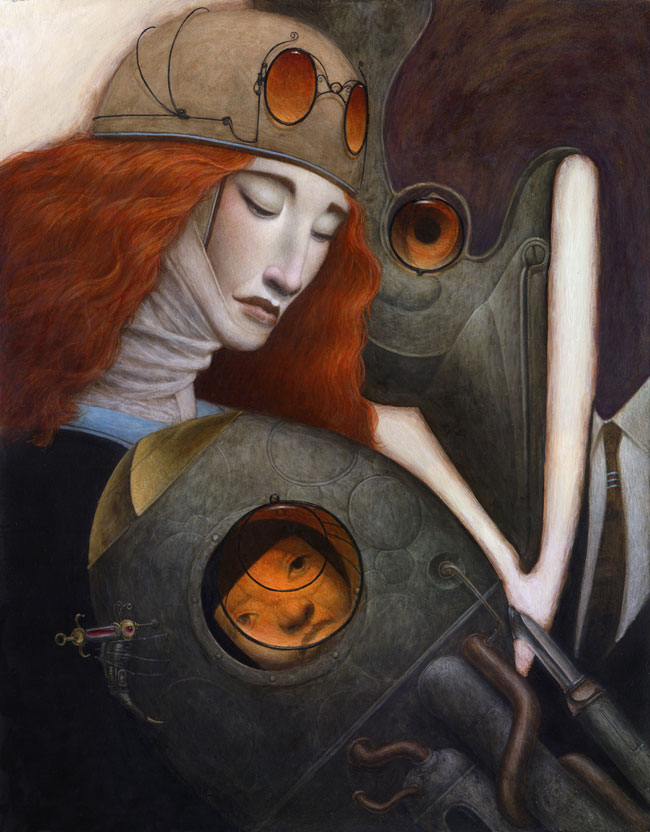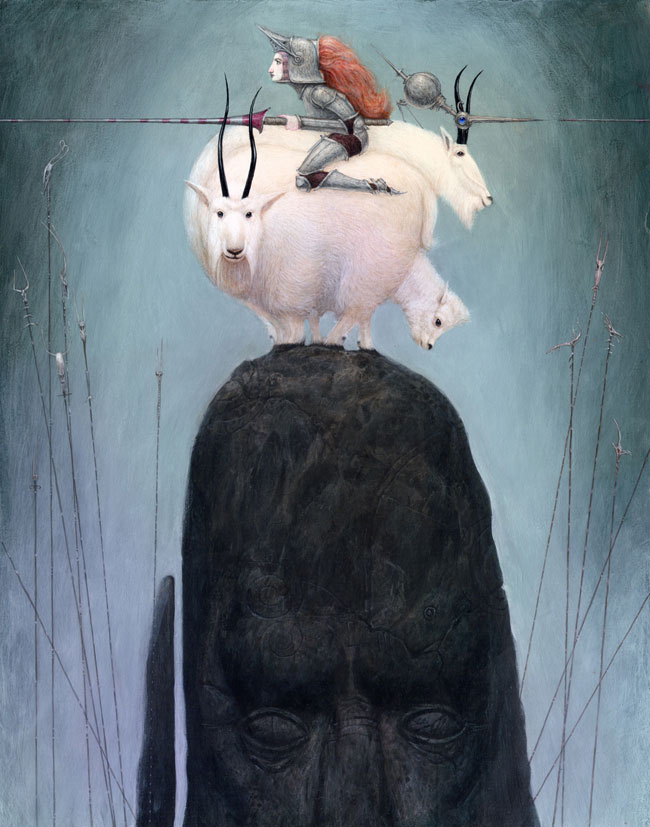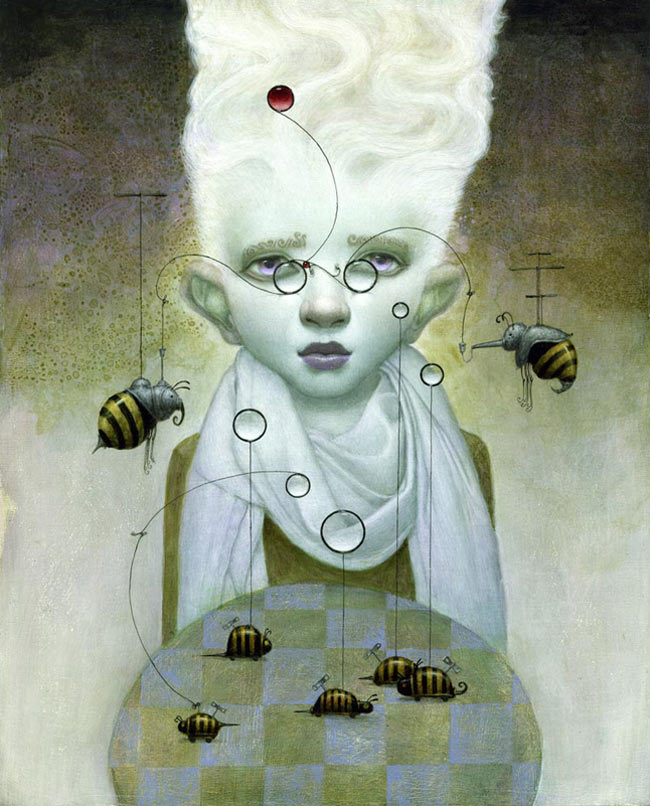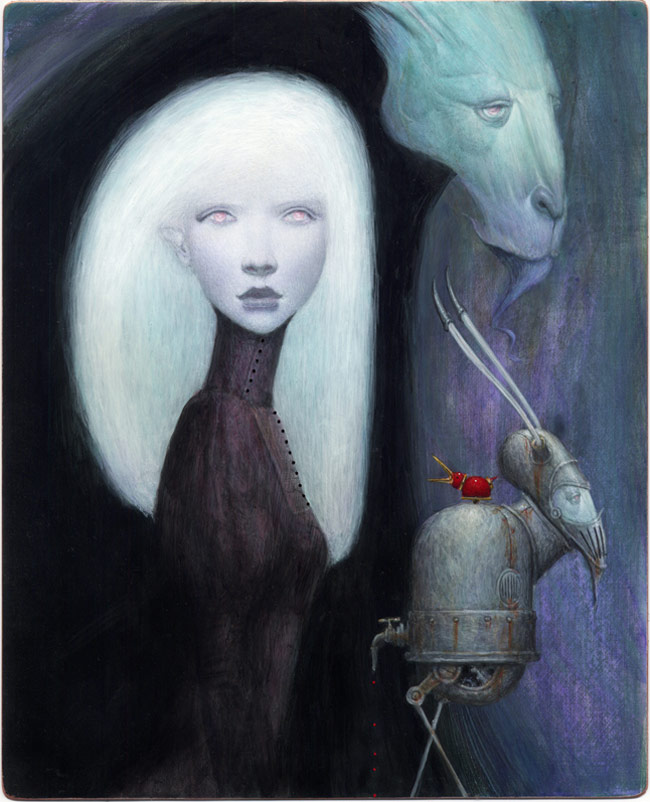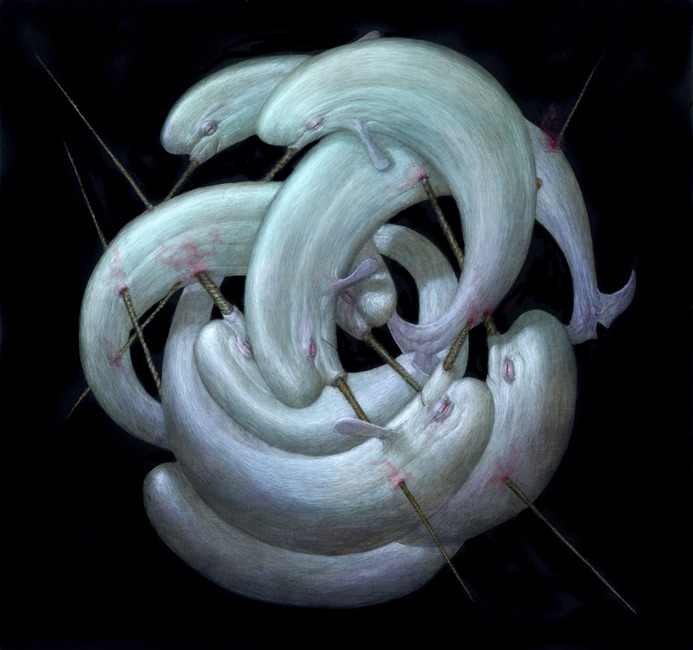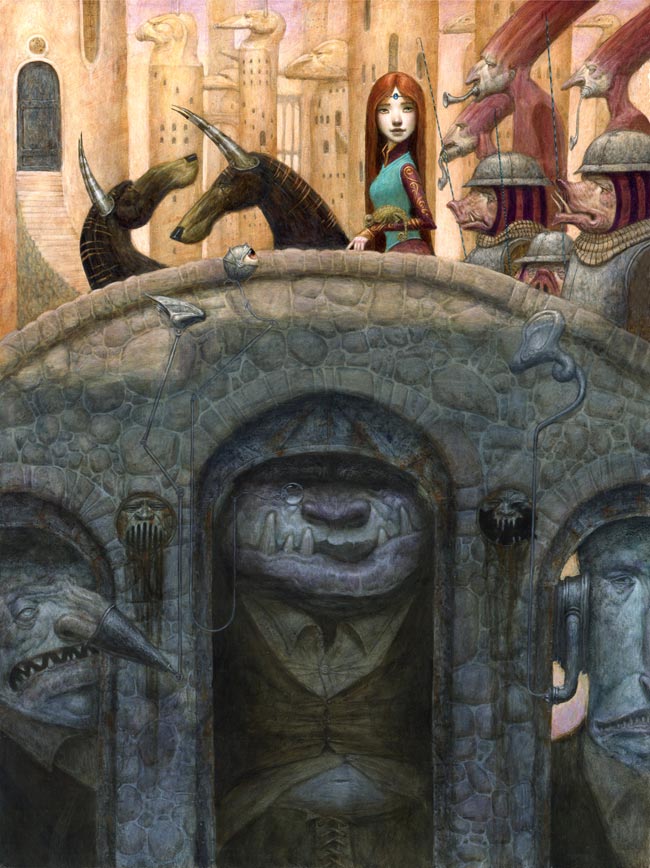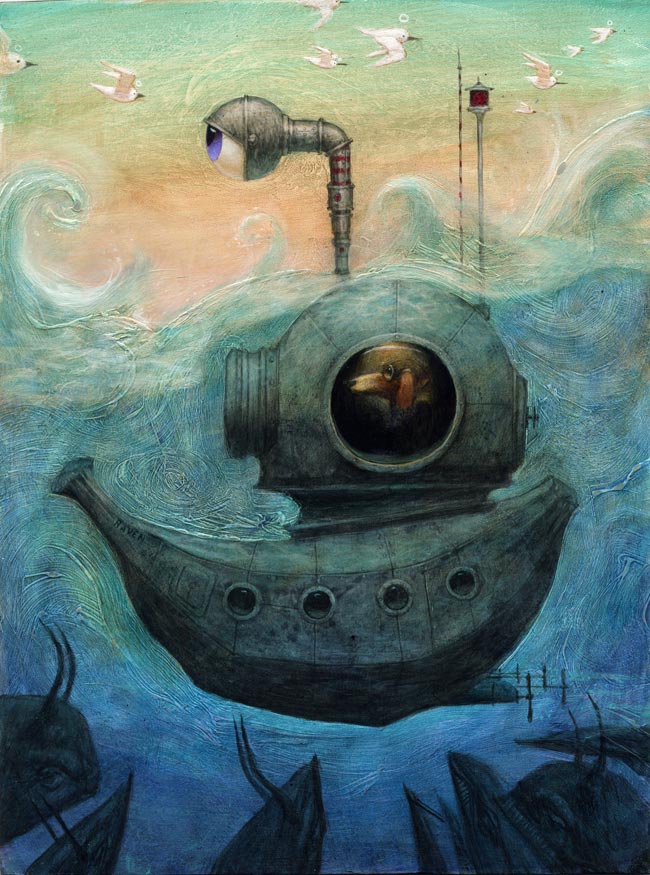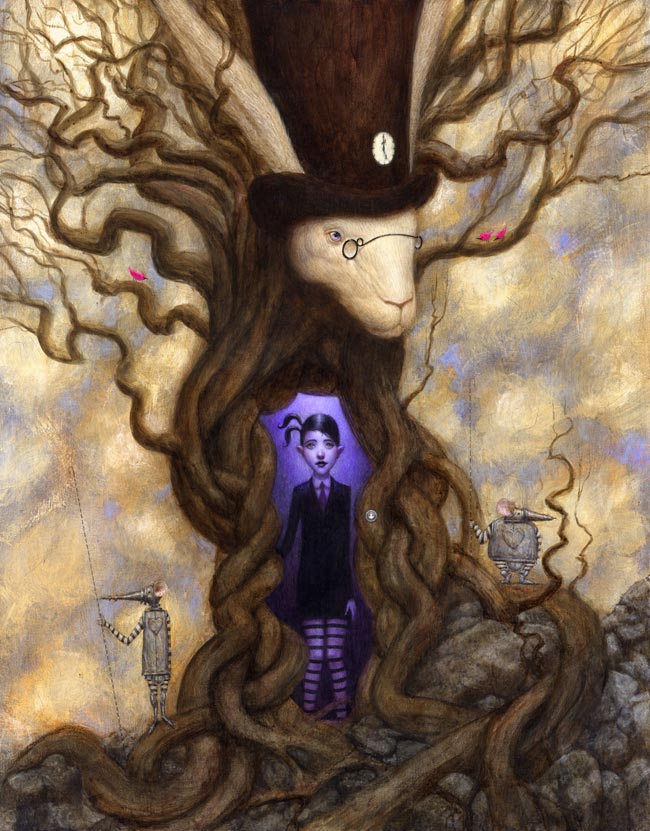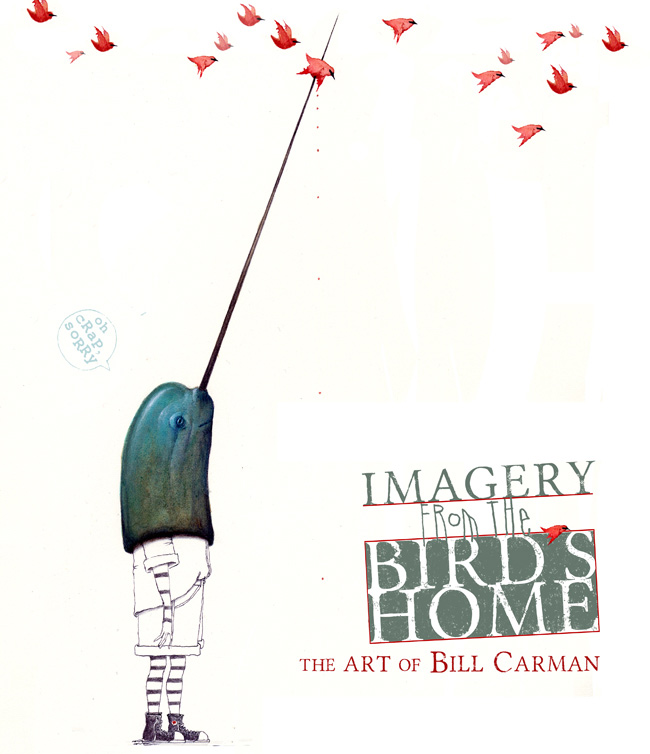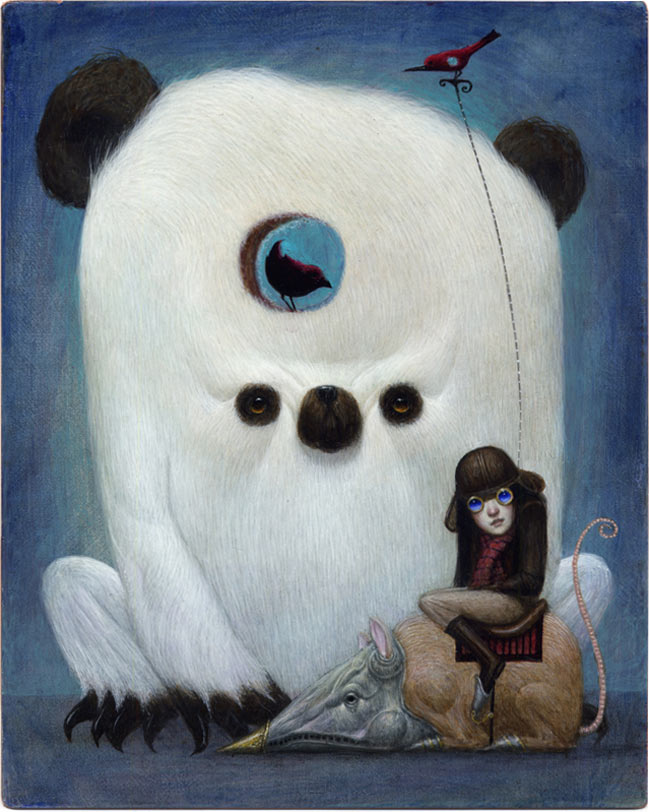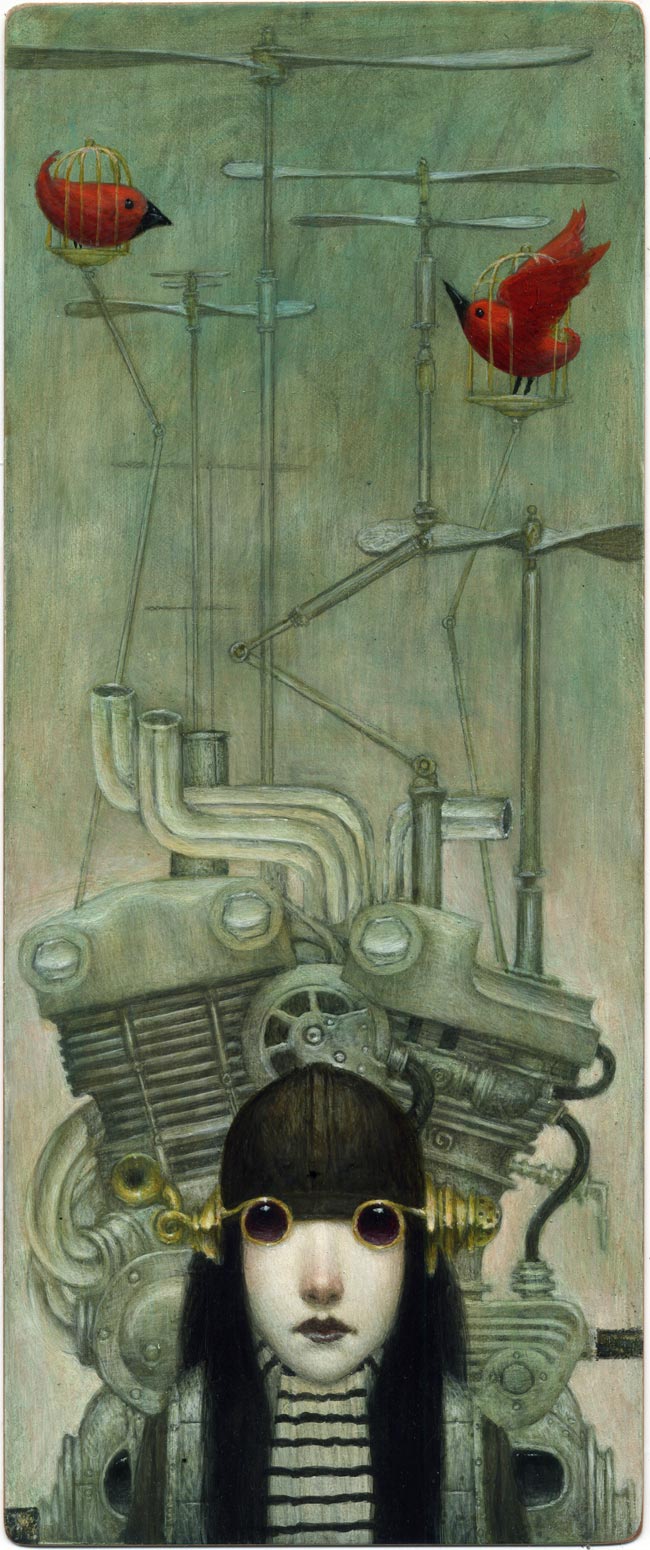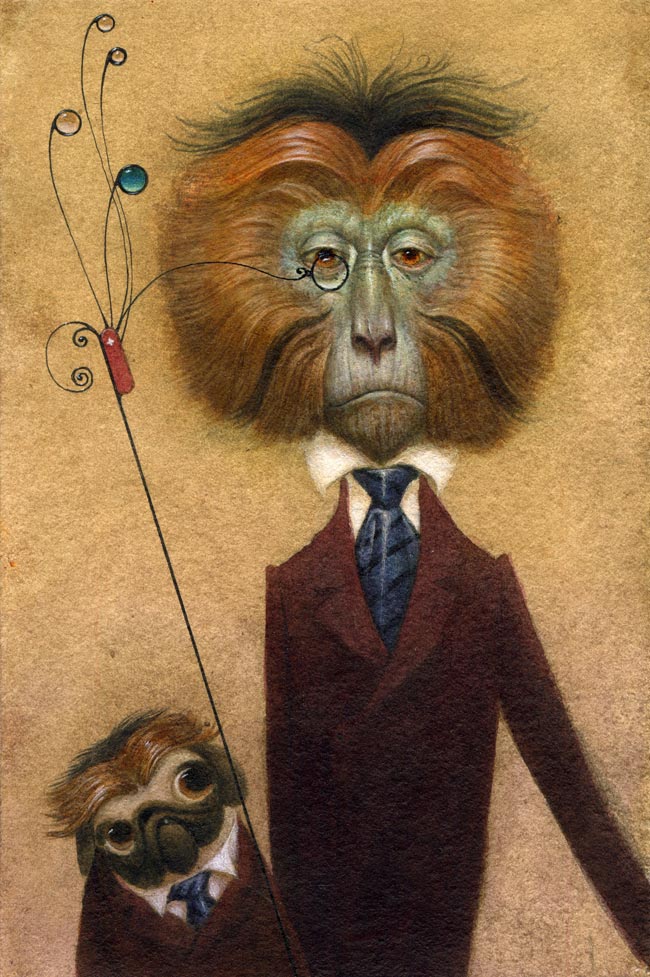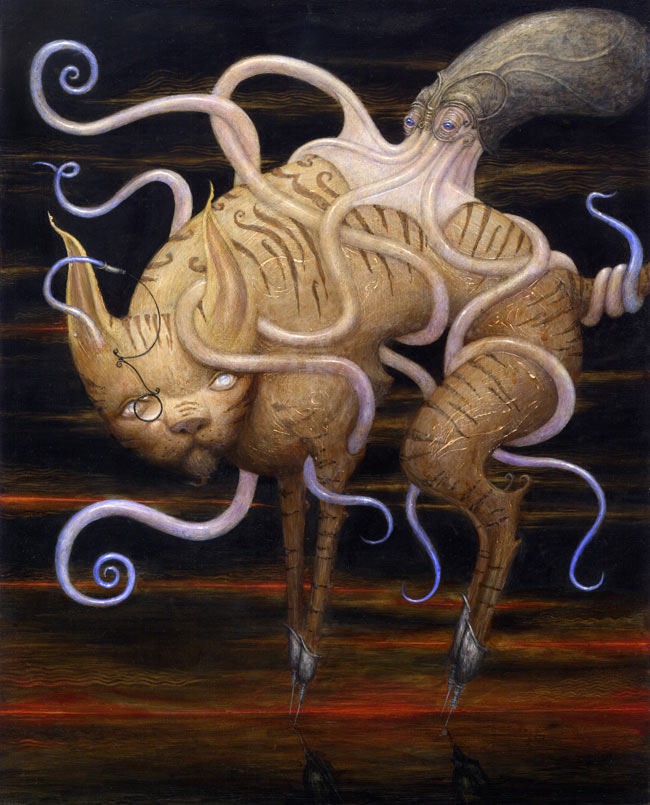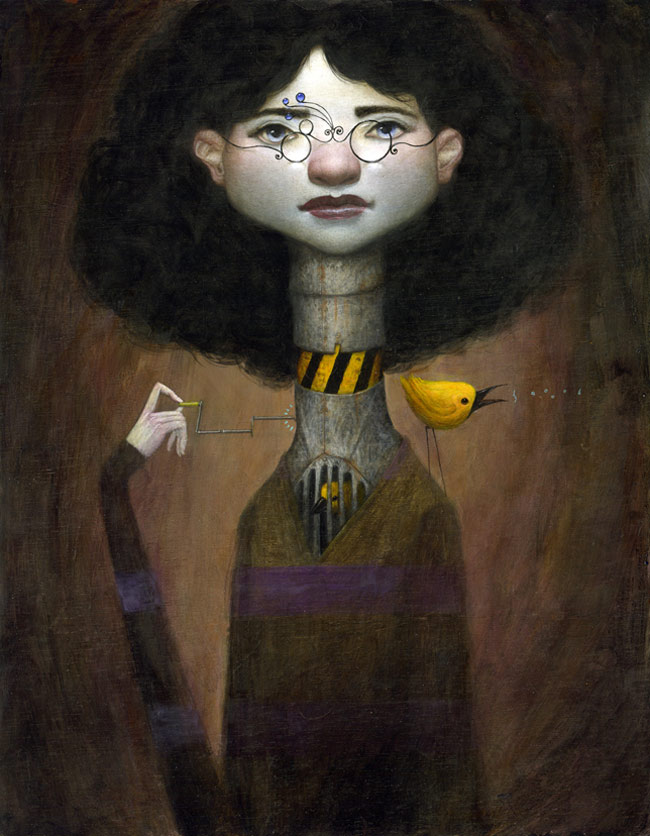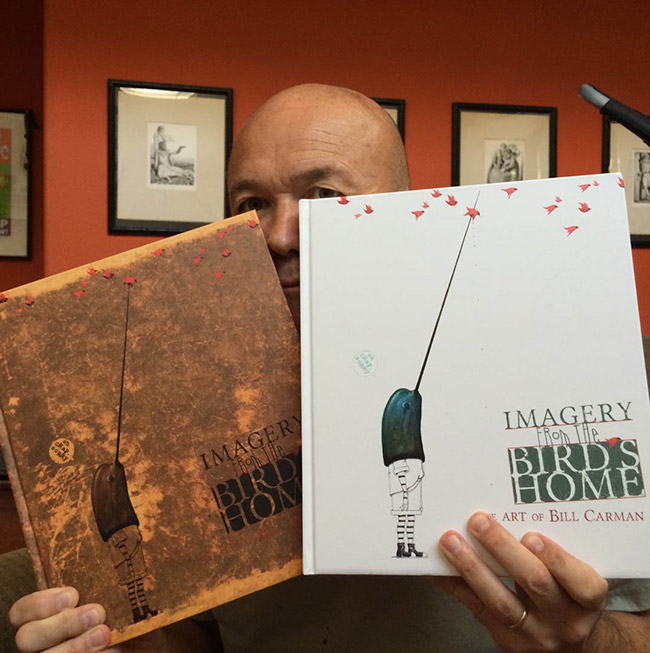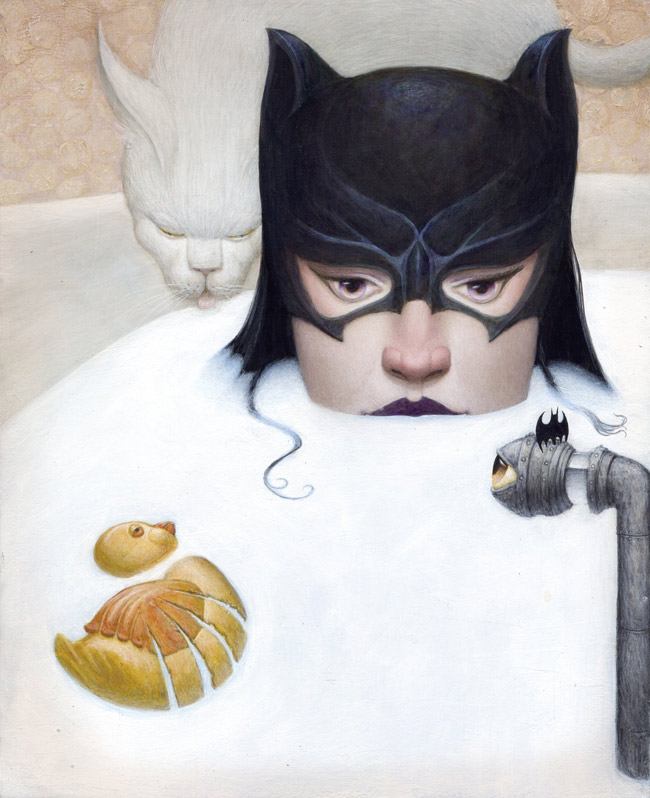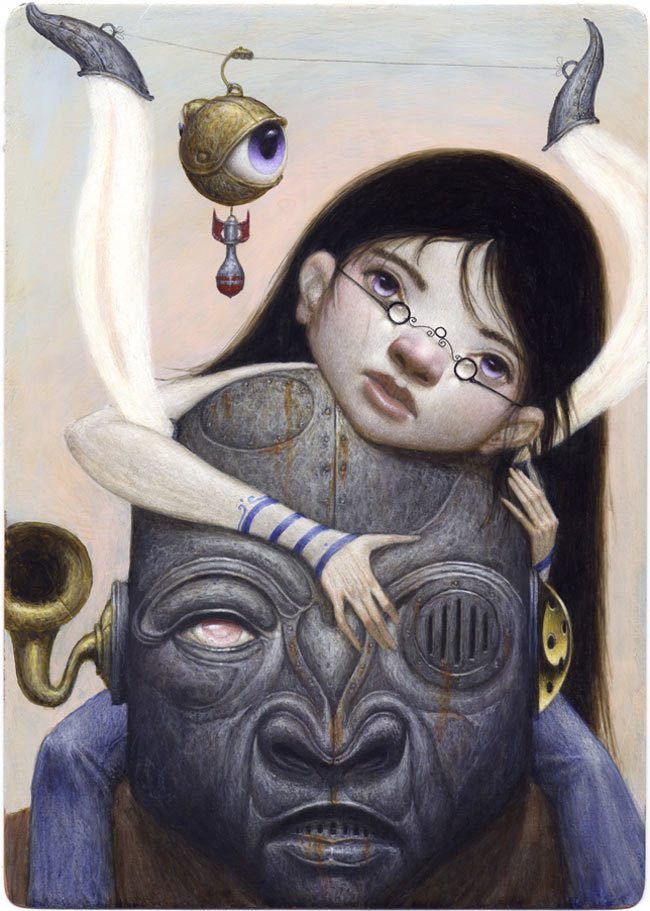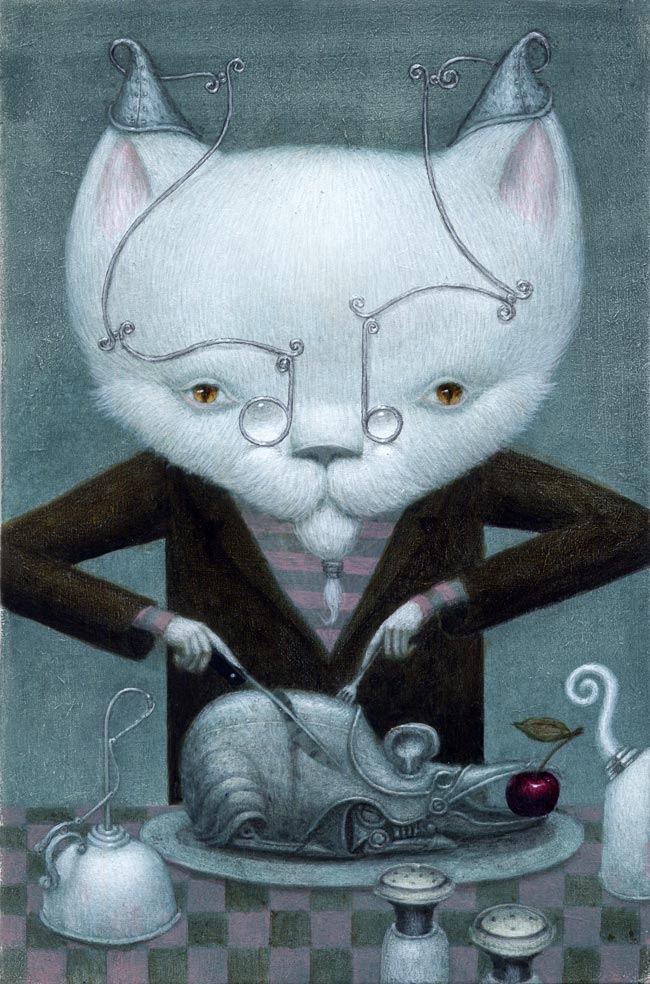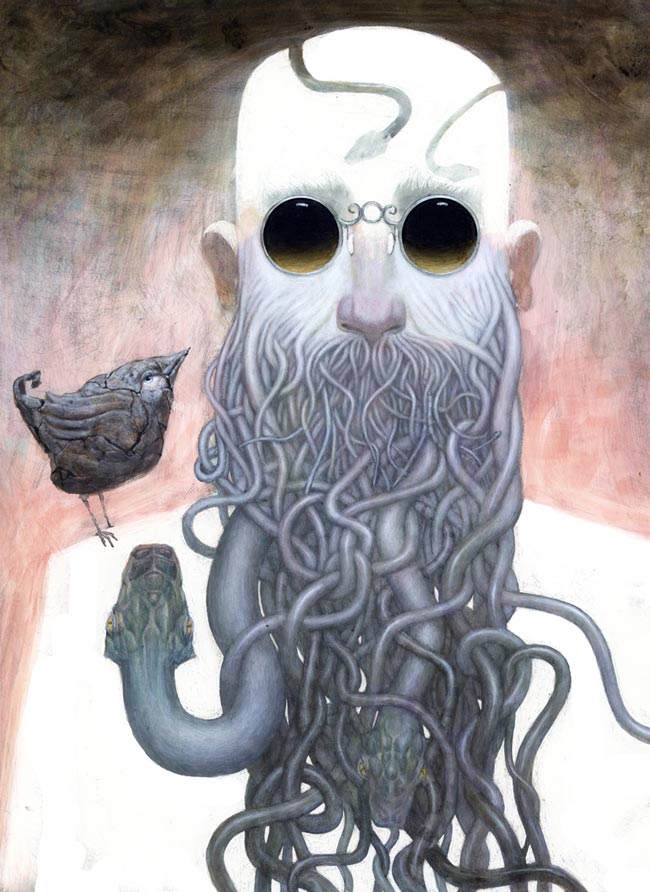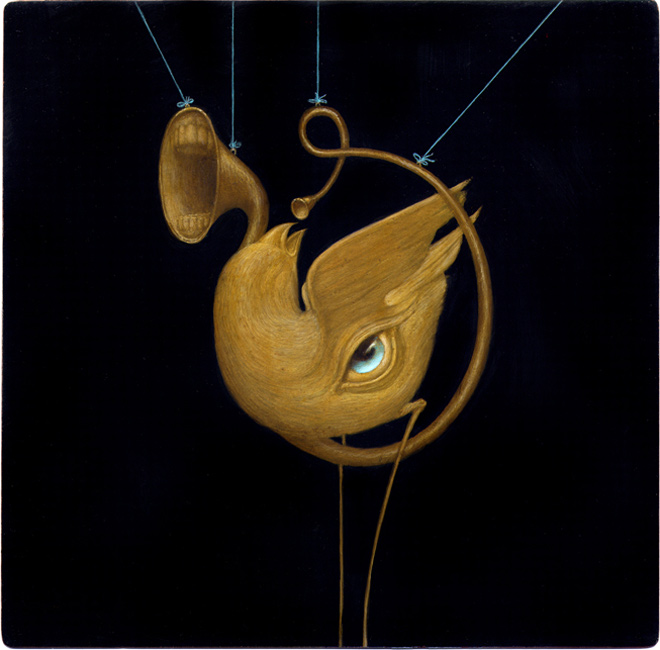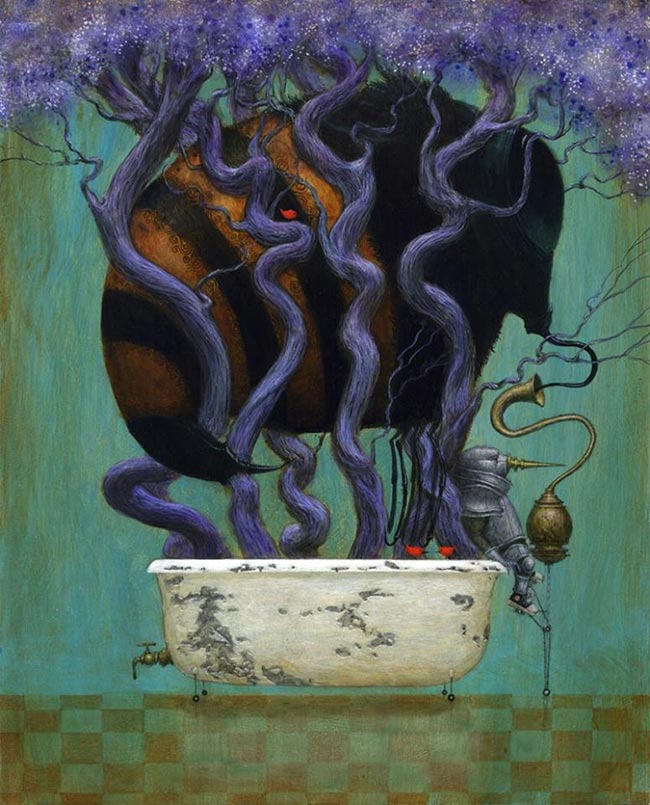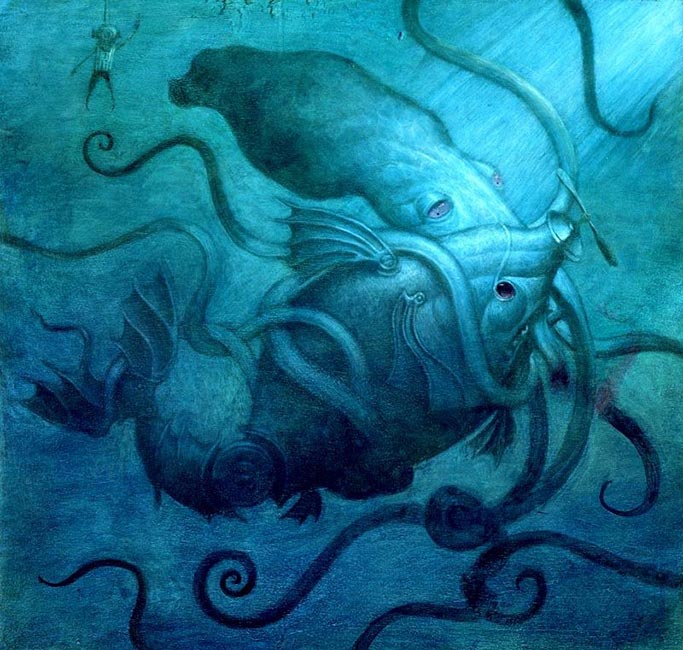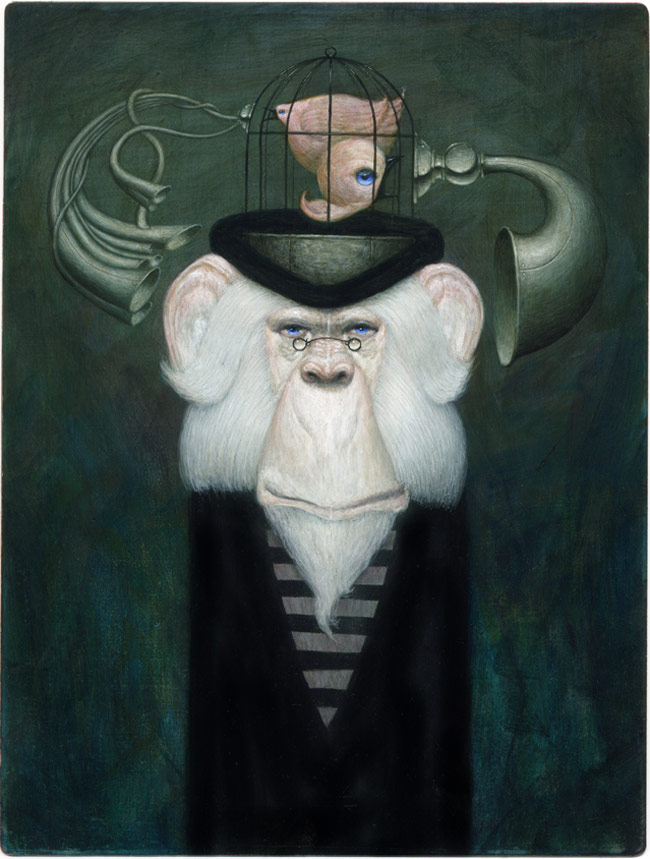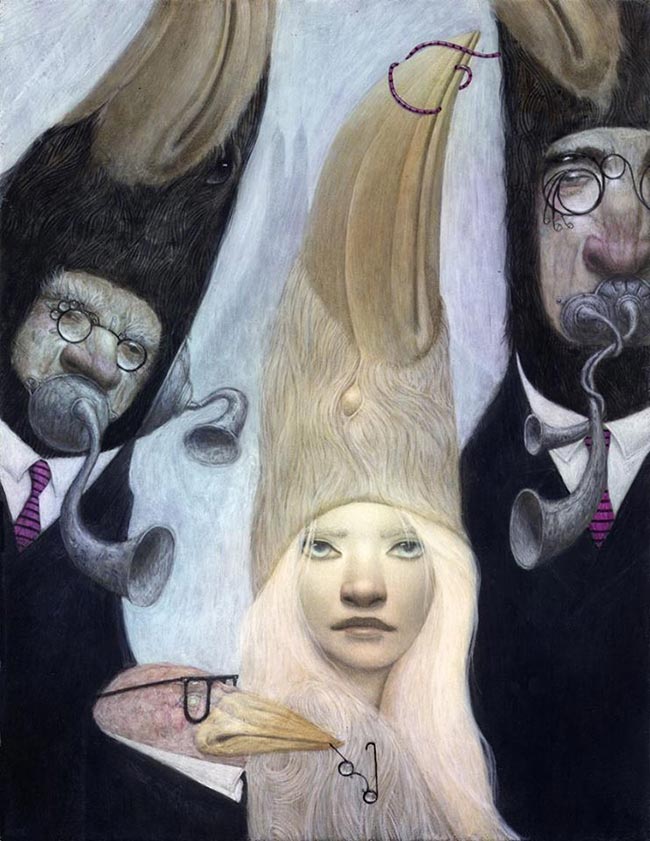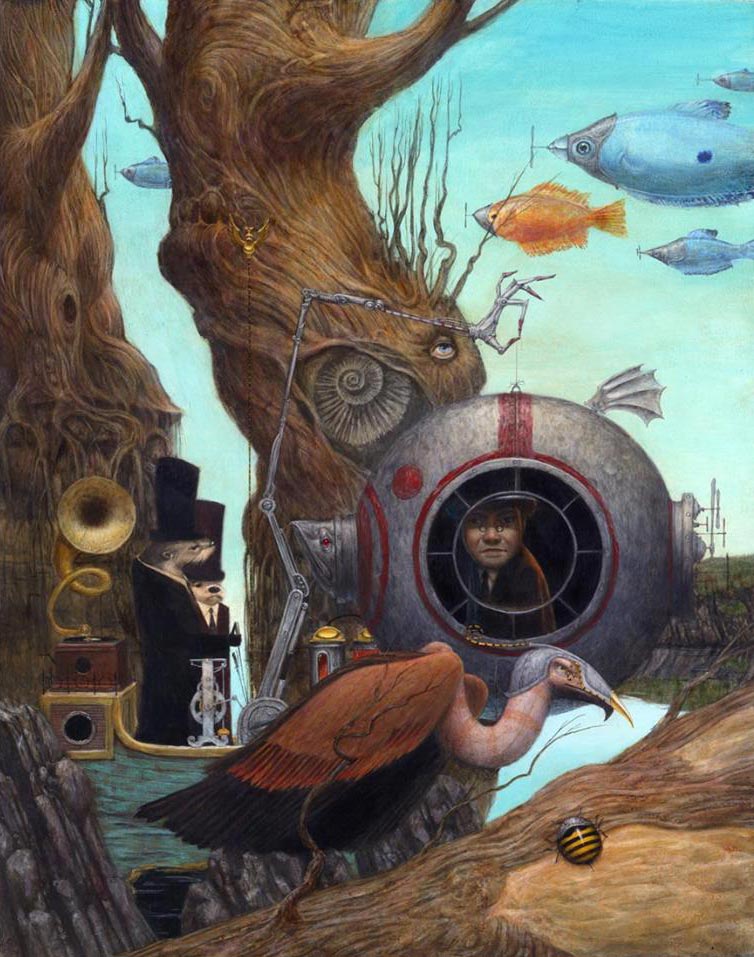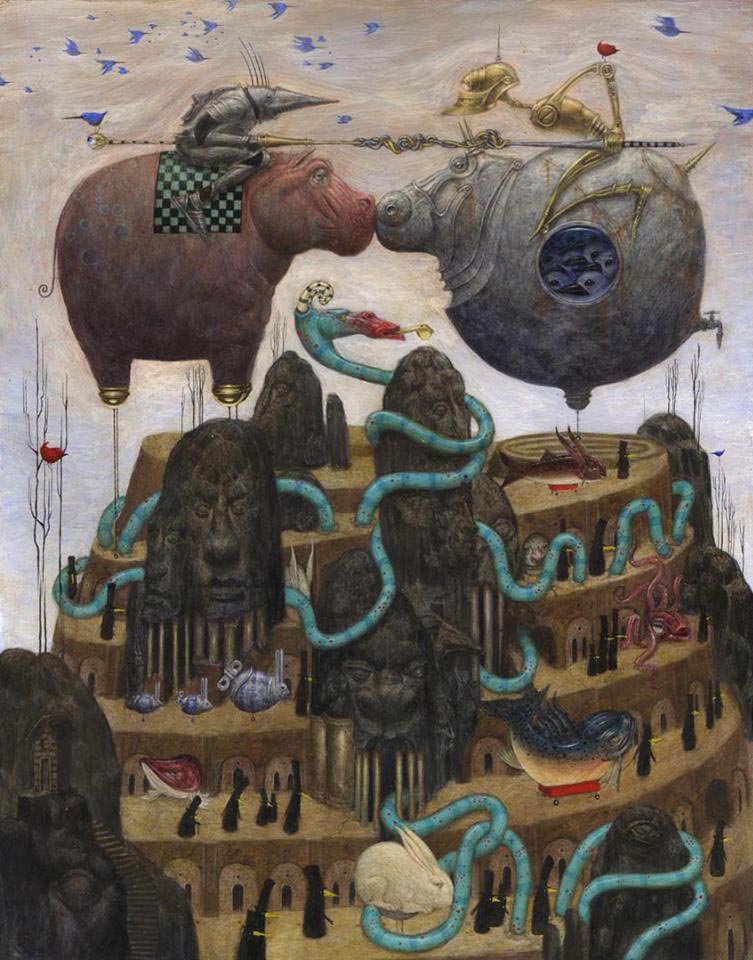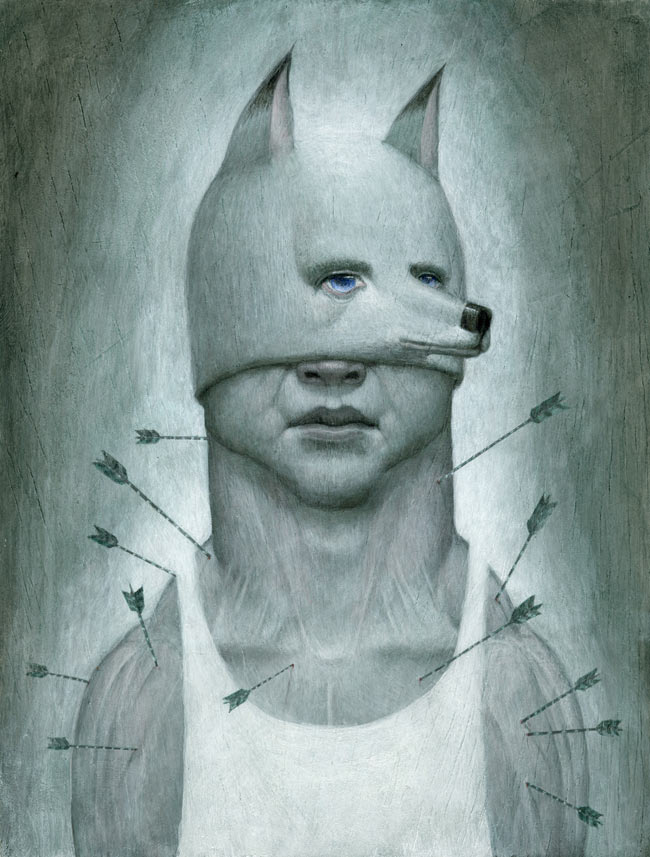Bill Carman’s images deliver undetermined narratives to their viewers, through a sophisticated fusion of imaginative characters, rich texture and mysterious charm. Add to this, the fact that Bill is an incredibly keen visual listener and you have a recipe for the emergence of some remarkably engaging dialogues. Opting to work on a wide variety of organic substrates, Carman responds to the surface he is painting on in a manner which allows for a scintillating conversation to arise between his subconscious mind and the tactile patterns and textures laying before his paint brush. Informed by his daily life, Bill’s image making is driven by a personal symbolism which manifests itself in darkly humourous ways and often appears in strangely familiar guises, welcoming our participation in the unfolding and deeply gratifying conversation cycle.
Bill Carman was born in Seoul in South Korea and grew up in Northern California. He studied at Brigham Young University where he attained a Master of Fine Arts. Bill now teaches as a professor of art at Boise State University and still finds time for a career as a professional illustrator and fine artist. His work has gained him numerous awards, including gold and silver medals at the Society of Illustrators New York Annuals.
WOW x WOW recently caught up with Bill on the eve of the release of his new book, ‘Imagery from the Bird’s Home: The Art of Bill Carman’. We were treated to such wonderfully candid and illuminating answers to our questions about Bill’s work and inspirations. Read on!
Hey Bill! First of all, thanks very much for taking the time to have this little chat, we really appreciate it. To start us off, if you would please introduce yourself, touching on anything you feel relevant to story of Bill Carman the artist?
Thanks for having me. The story of Bill Carman as an artist is long, disjointed, and probably boring. Moments from that long story can be exciting, unrelated, and revelatory. It started on the floor of a house in Seoul, Korea where, with the help of a midwife, a 90 lb Korean mother gave birth to an 11lb 14oz half Korean blond-haired baby. It continued with a childhood in a typical Northern California suburb where imagination was my primary tool in fighting off boredom. Probably part of the reason I started doing this art thing. Understanding oneself is pretty critical even if as a youngster it is instinctive. Although I was good at most school subjects when I wanted to be, I rarely wanted to be. So playing in bands, throwing the frisbee, doing stupid things, and drawing became my go to pursuits. No one in my family was particularly artistic, except a semi-famous poet somewhere in my family tree, Bliss Carman. But from the beginning I couldn’t seem to leave the art thing alone, so when it came time to go to school it was going to be visual art or music. I hope I chose wisely.
Tell us about where you are currently living and the creative community that you feel a part of through living there, if any?
I’m living in the high desert country of Boise, Idaho. The most obvious creative community is academic, a product of the university. But the most exciting community is one built of young artists who some years ago couldn’t leave the pop-surrealist/illustration thing alone. As a consequence it has grown into a tidy little community. One I would like to think I had some small part in building. It has a long way to go to catch up to our music and theater community but is slowly getting there. Boise has some liberal embers smoldering in a conservative state that will take a little more fanning to start to burn.
What is the impetus that makes you sit down and pick up a paint brush? Do you only work when you have an idea in mind or do you start painting and let the image unfold in a more organic way? How does the creative process work for you?
A huge question. There are so many ideas floating around that that is never the impetus for picking up a brush. I do it now because it is natural for me. It is part of me and who I am every day. It’s simply an extension of waking, stretching, doing 3 push-ups, making coffee, walking the dogs, etc. When I do make my way upstairs, if I’m not teaching, whether I choose a brush, pen or pencil might depend on the time of day. In the morning I like to sort things out – write, sketch, solidify ideas that come in the middle of the night. If I’m on some kind of tight deadline those things might take a back seat. I always have multiple things going. Usually one or two more involved paintings and then some smaller things. I like to keep scraps of paper and other surfaces within reach so I can grab them for quick relief. A change of pace, new little doorways to discovery.
The start of a piece can vary. Most often a seed of an idea interacts with marks on the surface and the visual dialogue begins. That journey always takes twists and turns and the process develops. Sometimes a clear narrative forms but most often it is a taste of narrative with multiple possibilities. Possibilities and journey is what keeps me interested and excited about what I do. But more often than not I start with a surface and texture. Finding directions and a dialogue through random textures might be the most enjoyable way to start a painting. The thing is that starting something the same way every time feels ruttish to me. So I try to mix things up, including taking on the occasional illustration. I still love the process of illustrating.
Storytelling and narrative are at the heart of the art you make. In your opinion, what are some of the most important ingredients that go into making a successful visual narrative?
My work is less about linear narrative and storytelling than it is about narrative possibilities. But if we want to talk about narrative in a larger sense then understanding the role of character comes first. Character can be a person, animal, thing or even place. Some authors like to outline story and character, a very organized approach to story building, while others may have a more organic approach letting character develop as the narrative unfolds. I probably belong to the latter camp when it comes to my more narrative pieces. I seem to start with a jumble of material in my brain and let it out in spurts as I respond to formal elements. As images and characters appear they start to tell their stories sometimes directly but most often with hints and possibilities. Sometimes those who look at my work have a better sense for the narrative than I do.
As you’ve mentioned, surface and texture play vital roles in your visual aesthetic. Talk a little about your love of texture. How much do you let the unpredictability and happy accident aspect of your painting style influence the overall compositions of your work?
I tell my students that surface and texture are my drugs of choice. Well pens and books might be a problem for me too. Surface determines the impetus of any piece, whether that surface has evident texture or not. I will start a painting on copper much differently than one on wood. I hesitate to sound to esoteric or artsy fartsy, but listening to what the surface tells me is critical to what I do. Maybe that is one of the reasons I don’t work on canvas. I don’t like what it’s saying. Or probably it’s just that I work small enough that the canvas texture just interferes. But the real magic for me is the faux textures created by the medium I choose. Most often it is acrylic paint. As I apply paint to surface, bubbles, marks, passages and streaks all present infinite visual possibilities. This is what I mean by dialogue. Listening with our eyes instead of always forcing our will onto a piece. So to answer your question of how much do I let the unpredictability and “accident” influence my work: a lot. The key to good conversation is real listening and for me the key to painting is good conversation.
As a visual artist, can you shed some light on some of the most important inspirations and influences on your work that aren’t visual?
Awareness of what’s happening around me. Attention to life and culture. The realization that reading plays a critical role in development. The connection that literature and other forms of art have to the process I go through as a visual artist. Understanding that when I read a book or listen to music it is built through process similar to mine in many ways. The story or song is great but when I return to a specific paragraph, sentence, or passage over and over again I ask myself why? As I paint and make marks am I enthralled with the marks I’m making, with this color next to that, or one shape against another? Will I or others return not only to my painting as a whole but moments of texture, color, and mark and read them like a beautiful passage of literature? I realize this is sounding a bit grandiose but aspiring to the profound is never a bad thing is it?
You can be quoted as saying that some of your works “stare back and challenge that mad place that lies deep in our brains.” Can you share some of your thoughts about this part of the mind that you refer to and what you feel it’s role is in helping us understand art and therefore ourselves?
The title of my new book is ‘Imagery form the Bird’s Home: The Art of Bill Carman’ We use the term bird brain as a pejorative. A bit looney, loopy, etc. But why would we equate a negative with such an incredible animal. They build, communicate and fly. I can’t think of a better metaphor for freedom, risk and doing. So for me a Bird Brain is not the brain of a bird, but someone who has invited a bird to roost in their head. We all have bird brains as children but when they fly south after we fill our heads with ‘logic’ most of us never invite them back. And only a few of us have encouraged them, from the moment we know they are there, to make our minds a permanent home. That bird’s home is a place where there is no need to conform, no criticism or uncriticized criticism, and certainly no chance of being put in creative or any other kind of jail. I describe this place by telling others what it isn’t, because what it is is surely different for everyone. But there are always commonalities, those things that we share. And when we see a piece that we love, when we hear music that not only moves us to emotion but touches something deeper we may be sharing that mad place. A place we recognize but can’t describe. A place we are forced to describe by what it isn’t because there are no words for what it is. I have theorized that historic masterpieces may overlap onto more peoples’ mad places than most things hence the greater agreement on the term masterpiece.
How deeply do you allow the autobiographical currents within your work to flow? When looking back at individual pieces from your back catalogue, do you feel that they show what you were experiencing or going through around he period of their creation?
I think autobiographical currents are unavoidable even if only on the level of, ‘I remember the song that was playing, the game that was on, or what movie was running in the background,’ as I painted this piece. Sometimes the autobiographical/social chord is much deeper. A particular memory or even outrage is connected to a piece or series. It seems easier these days to be outraged because we are connected to the world in so many ways. Maybe creating work whether directly or tangentially inspired by these sound bites helps to give me greater understanding or connects me more to an issue – introduces if not empathy then surely sympathy. Maybe it can help place me in an absurd world. Very rarely one of my pieces will be directly autobiographical. In fact the biography in the back of an upcoming book of my work is half tongue in cheek text and half a specifically autobiographical image.
Being a professor of art, do you feel that your interaction with your students has any affect your own work?
Absolutely. My guys (A word I have used forever to describe my female and male students. I think it’s a Magnum PI thing) keep me fresh. They knowingly and unknowingly are demanding. I can’t imagine teaching what I do without being entrenched in its world. And I love the world of contemporary art and illustration as maddening and undefinable as it is. Maybe the influence of my students on my work is not directly related to the individual pieces but more to the desire for relevancy in a world of incredible artists.
What do you feel is the most vital factor for an artist to be open to, with regards to the evolution of their practice? Having had a lengthy and successful career so far, how have you seen your own work evolve over time?
Be open to the idea of hard work but remembering that hard work can be enjoyable if you like what you are doing. And if you like what you are doing it should help you through those not so fun moments as you build a passion. And as your enjoyment turns to passion you’ll find that stopping is not an option, even when those difficult moments become unbearable. Be open to the idea that being an artist may not be as romantic a notion as is often advertised. Work at being good at what you do not at being seen as a good version of what an artist is. Be open to honest awareness. Learn to know yourself and what you want, then the things necessary to get you there. Awareness that quality time is the secret ingredient. If you choose the path of family then that journey might take a little longer, it did for me, but if it’s a conscious decision then you won’t be surprised. Awareness is a great word.
Like anyone doing this thing we call art I’ve had hills and valleys in my career. I had a family early and knew that to support them I would need to have a job and build my chops over time in those “extra” hours. It’s interesting to see that as time moved along my career had a slow steady climb but took a sharp up turn as the kids grew older and I had more time to work. That was my natural arc. My voice became more and more mine and once I started teaching that personal voice grew exponentially.
In order to get a better understanding of the personality of an artist, it can help to get a peek behind the curtain. Would you be willing to share a story from your own life, one which you feel has contributed to shaping the person and therefore the artist you are today?
When you look at contemporary imagery particularly as it relates to pop surrealism there are symbols that have popped up regularly and seemingly repeated ad-nauseum. But some of those symbols are important to me and had been a part of my work long before the west coast movement became ubiquitous. I’ll save the bunny stories for another time but cephalopods hold a particularly warm place in my psyche.
I was probably a pre or early teen when our family went on an outing to Moss Landing, a beach in California. Our outings most often included fishing as an integral component. I remember the water being more a calm bay than surf on a beach on that particular day. We fished and caught nothing except maybe a small perch here and there. The moment came when I felt my line stop. I reeled and then it moved. Whatever I had was heavier than a perch. I was excited as I knew I had caught the big one. It was a rare moment when I surpassed my dad fishing. As I continued to reel, my excitement overshadowed the fact that the fish, though heavy, didn’t seem to be putting up much of a fight. When I finally landed my prize it was to laughter from my dad, mom, and brother. My heart sunk when I realized it was a large tin can. World’s best fisherman might have been a sarcastic remark I heard among others. But at my darkest moment the can moved and something seemed to unfold and pour out of it. That dark moment became a great triumph when we all realized that we would be having fresh octopus for dinner. What my mother could do with any cephalopod, octopus being my favorite, makes my mouth water to this day just thinking about it.
The point of this story is that there were very few if any ‘ah-hah’ moments. I have become what I am though an accumulation of a lot of moments both memorable and not.
What is the most memorable thing anyone has ever said about your art?
I think more memorable are reactions when people confront my work. At a gallery opening a red-haired woman was standing for the longest time in front of my painting. It was a humorous piece called ‘Spit Jugglers’, which included two masked faces spitting arcs over a red-haired woman. I approached her and identified myself when she asked, “What does it mean?” I could see tears forming in her eyes then roll down her face. How could I tell her it was basically a nonsense painting. Just as I opened my mouth she said,”Wait, don’t tell me.” She pulled out cash and bought it on the spot. One of the reasons I hesitate to tell people the meaning of my individual pieces even when I know it, is that they often know more than I do.
There are a couple of quotes referring to the ever present ‘whimsical’ when people refer to my work that I’ve heard or read. Both are paraphrased I believe, but put a positive spin on a word I can’t seem to escape.
“Bill Carman is to whimsical what light year is to inch”
“Bill Carman is looking at whimsical in his rear view mirror”
If you could own any piece of art from the world’s collections, what would it be and why?
Probably Van Eyck’s Ghent Altarpiece. Although I would hate to take it from where it belongs. If there is one pilgrimage that I want to make to see a work of art it would be to see this. So many brilliant works in one beautiful whole.
What’s next for Bill Carman?
Well I hinted, none too subtly, that a book of my work is being release in October 2015. You can pre-order the collector’s edition from Flesk Publishing or the trade hardback from Flesk, Amazon or any number of other online bookstores and distributors. It’s packed full of images and much less long winded than this interview. I’m in a group show coming up in LA in September, a tribute to Guillermo del Toro at Gallery 1988. A group show called Pandora’s Box, quite the list of artists, at AFA NYC Gallery Soho during December 2015. Looks like I’ll be there for the opening and to sign books. And continued secret projects. Come and hang with me at my FB page or my site billcarman.com which I promise to update to a real site soon.

